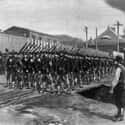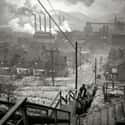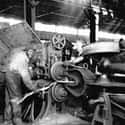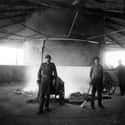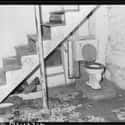-
(#2) Workers Riots Took A Back Seat To Capitalist Hegemony, As Evidenced By The Homestead Strike
In 1892, the Amalgamated Association of Iron and Steel Workers, one of the country's largest unions, with more than 20,000 members, clashed with robber baron Andrew Carnegie and his Carnegie Steel Corporation in Homestead, just outside Pittsburgh. The union organized a massive strike, intent on creating a new collectively bargained agreement guaranteeing better working conditions and pay. Instead, Carnegie locked the workers out of the factory, erected fences, brought in snipers, refused to agree to the workers's terms, and hired scabs to work in their place.
Violence erupted on July 6, when Pinkertons hired by Carnegie to protect the scabs clashed with workers. The violence escalated such that a state militia was brought in the next day. During the melee, which involved workers firing canons at ships on the nearby river, seven workers were killed, 20 shot, and more than 300 injured. No new agreement was reached, the strike crumbled, and the workers returned to the same conditions they went on strike to protect.
-
(#10) Single Male Immigrant Workers Turned Vice Into A Major Industry In Formerly Sleepy Towns
Many migrant workers were single men from peasant communities in Europe looking for work and a new life. Croatians, for instance, left home en masse as the political and social make up of the country changed drastically, divesting them from land and, thereby, their livelihood. Because most of these migrant men were single, and those who weren't often left their families behind in the old country, a vice industry quickly developed in steel towns throughout Pennsylvania.
According to Explore Pennsylvania, the state's official history portal, "
"The presence of large numbers of single men also fueled the growth of a large 'vice industry' centered on prostitution, alcohol, and gambling, which prospered in many mill towns. Homestead's Sixth Avenue hosted one of the gaudiest sin strips in America. In McKeesport, 'Brick Alley' was a renowned red-light district with mostly African-American women workers."
-
(#9) The Mills Were Racially And Ethnically Segregated
Steel towns were hubs for migrants and immigrants. African Americans flooded the Pittsburgh area looking for work as immigrants came in droves from across Europe. The racial hierarchy placed black at the bottom, northern and western European whites at the top, and everyone else somewhere in the middle.
Jobs were apportioned based on this hierarchy. African American workers were given the worst, most menial, or most dangerous jobs. In the documentary Struggles In Steel, black workers remember training white men who became their bosses months, weeks, or even days thereafter. Some came in early to learn how to operate heavy machinery in the hopes of getting a promotion, only to get passed over.
Supervisors were often Irish or Irish-American. Slavs, Serbs, Hungarians, African Americans, and other oppressed peoples found themselves in harms way. "In blast furnaces, aside from the Irish foreman, there are seldom any but Slavs or Hungarians employed," John Fitch observed around 1910.
-
(#5) A Steel Worker Earned $423 Per Year
No doubt things were less expensive in 1934, but $423 per year for 84 hours a week? That's $7,926 in 2017, adjusted for inflation. And this was a wage for a person who was lucky enough to have a job. By the early '30s, steel production began to slow a bit and mills were on hiatus. Things picked up when America entered World War II, but in 1934, many workers were unable to find a job in a mill were often put to the streets.
To give some indication of what $423 meant from 1932 to 1934, in the same period, your average waiter earned $520 annually, construction workers $907, public school teachers $1,227, doctors $3,382, and Congressmen $8,663. The average three room apartment in New York City ran $15 a month, a bicylce cost around $7.00, and work pants about $1.25. You get could a pound of bacon and a pound of coffee for less than 50 cents.
To put this in perspective: despite how cheap goods were, $423 annually means $8.13 per week, or $32.53 per month, and that's not considering what mill owners garnished for housing costs.
-
(#6) The Pittsburgh Toilet Exists Because Of Steel Mills
You may be asking yourself, "What the hell is a Pittsburgh toilet?" It's a toilet in a basement with no walls or stall surrounding it, often paired with a sink or washbasin. There were also sometimes shower heads nearby. Such toilets were common in houses built before Word War 2 in Pittsburgh, and can still be found in the 21st century.
That's weird. Why the hell would you want that? Well, when men returned home from the mills, they'd be filthy dirty and need a place to do their business and wash up before entering the main home. So, the basement was turned into a makeshift clean-up station. A bathroom, shower, laundry tub all in one place!
-
(#3) Steel Mill Work Was Brutal And Profits Trumped The Value Of Human Life
Working conditions in the steel mills of Pittsburgh were brutal, and the world the workers inhabited was remorseless. According to a profile of Andrew Carnegie in The Economist, "Fatal accidents in the steel mills... accounted for 20% of all male deaths in Pittsburgh in the 1880s. Newspaper lists of men killed and wounded each year were as long as a casualty list for a small battle in the American civil war."
By 40, most men's working life was over. If they hadn't died from the hazards of their occupation, they succumbed to the savage conditions of the mill (extreme temperatures, equipment with no safety measures): their bodies and/or minds were wrecked beyond repair. These workers put in 12-hour days seven days a week, and some of them started in the mill as children. Injured workers were let go and forced to cover their own medical bills, and anyone injured or deceased was quickly replaced by one of the countless immigrants arriving in Pittsburgh every day.
Regarding the deaths, "Carnegie could not have cared less. When a steel furnace exploded, he worried about loss of production, not loss of life." The families of the deceased were not compensated, predictably.
New Random Displays Display All By Ranking
About This Tool
From the 1900s, Pittsburgh steel mills developed rapidly and became one of the centers of the American Industrial Revolution. At that time, Pittsburgh steel production accounted for one-third of the total steel production in the United States, and even more than half after World War II. But what followed was heavy pollution of the environment and air, and the whole city was densely covered with black smoke, which can be said to be hell with the lid off.
Nowadays, Pittsburgh is considered a model for the successful transformation from a traditional industrial city to a green city. But we should not forget how horrible life was in Pittsburgh, welcome to check the random tool if you want to learn more about the brutal facts about Pittsburgh steel mills.
Our data comes from Ranker, If you want to participate in the ranking of items displayed on this page, please click here.











